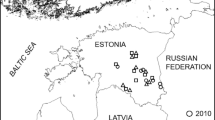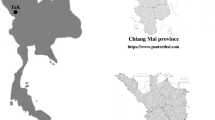Abstract
Genotypic changes in populations of Phytophthora infestans in Southern Flevoland (150 km2) were analysed by characterising isolates from potato refuse piles, conventional and organic potato fields, and potatoes and tomatoes in allotment gardens for mating type (1712 isolates) and DNA fingerprint pattern using probe RG57 (1048 isolates). The overall percentages of genotypes (and of isolates) that were A2 varied from 32 (4) in 1994 to 45 (56) in 1996. Among the 1048 isolates 170 different genotypes were identified, of which 138 (81%) were ‘rare’ (i.e., detected in only one sampling site in the research area during 1993–1996). Many rare genotypes were encountered in organic potato fields and in allotment gardens. In 1994 and 1995, four genotypes were abundant. The highest percentages of isolates with these ‘common’ genotypes were encountered in refuse piles and conventional potato fields. The common genotypes were nearly absent in 1996, suggesting that the population may have passed through a bottleneck at the transition from 1995 to 1996. The Shannon index of genotypic diversity was high in allotment gardens and in organic potato fields. For the total populations the normalised Shannon index of genotypic diversity increased from 0.34 in 1994, with weather favourable to late blight, to 0.61 in 1996, with unfavourable weather. The high numbers of rare genotypes detected every year indicate that oospores may act as an infection source in commercial potato fields. However, refuse piles were identified as the most important infection sources for commercial fields in 1994 and 1995. In 1996 disease in commercial organic fields was probably initiated by a few genotypes originating from seed tubers. In allotment gardens oospores were probably the most important infection source.
Similar content being viewed by others
References
Andrivon D (1994) Race structure and dynamics in populations of Phytophthora infestans. Canadian Journal of Botany 72: 1681-1687
Baev PV and LD Penev (1995) BIODIV: Program for calculating biological diversity parameters, similarity, niche overlap, and cluster analysis, version 5.1. Exeter Software, NY
Bowman KO, Hutcheson K, Odum EP and Shenton LR (1971) Comments on the distribution of indices of diversity. In: Patil GP, Pielou EC and Waters WE (eds). Statistical Ecology Vol. 3. Many Species Populations, Ecosystems, and System Analysis. (pp 315-359) The Pennsylvanian State University Press, University Park and London. 462 pp
Caten CE and Jinks JL (1968) Spontaneous variability of single isolates of Phytophthora infestans. I. Cultural variation. Canadian Journal of Botany 46: 329-348
Davidse LC, Henken J, Van Dalen A, Jespers ABK and Mante lBC (1989) Nine years of practical experience with phenylamide resistance in Phytophthora infestans in the Netherlands. Netherlands Journal of Plant Pathology 95(suppl 1): 197-213
Day JP and Shattock RC (1997) Aggressiveness and other factors relating to displacement of populations of Phytophthora infestans in England and Wales. European Journal of Plant Pathology 103: 379-391
Drenth A, Goodwin SB, Fry WE and Davidse LC (1993) Genotypic diversity of Phytophthora infestans in the Netherlands revealed by DNA polymorphisms. Phytopathology 83: 1087-1092
Drenth A, Tas ICQ and Govers F (1994) DNA fingerprinting uncovers a new sexually reproducing population of Phytophthora infestans in the Netherlands. European Journal of Plant Pathology 100: 97-107
Drenth A, Janssen EM and Govers F (1995) Formation and survival of oospores of Phytophthora infestans under natural conditions. Plant Pathology 44: 86-94
Forbes GA, Escobar XC, Ayala CC, Revelo J, Ordonez ME, Fry BA, Doucett K and Fry WE (1997) Population genetic structure of Phytophthora infestans in Ecuador. Phytopathology 87: 375-380
Forbes GA, Goodwin SB, Drenth A, Oyarzun P, Ordonez ME and FryWE (1998) A global marker database for Phytophthora infestans. Plant Disease 82: 811-818
Fry WE, Drenth A, Spielman LJ, Mantel BC, Davidse LC and Goodwin SB (1991) Population genetic structure of Phytophthora infestans in the Netherlands. Phytopathology 81: 1330-1336
Fry WE, Goodwin SB, Matuszak JM, Spielman LJ, Milgroom MG and Drenth A (1992) Population genetics and intercontinental migrations of Phytophthora infestans. Annual Review of Phytopathology 30: 107-129
Fry WE, Goodwin SB, Dyer AT, Matuszak JM, Drenth A, Tooley PW, Sujkowski LS, Koh YJ, Cohen BA, Spielman LJ, Deahl KL, Inglis DA and Sandlan KP (1993) Historical and recent migrations of Phytophthora infestans: Chronology, pathways, and implications. Plant Disease 77: 653-661
Goodwin SB and Drenth A (1997) Origin of the A2 mating type of Phytophthora infestans outside Mexico. Phytopathology 87: 992-999
Goodwin SB, Drenth A and Fry WE (1992a) Cloning and genetic analyses of two highly polymorphic, moderately repetitive nuclear DNAs from Phytophthora infestans. Current Genetics 22: 107-115
Goodwin SB, Spielman LJ, Matuszak JM, Bergeron SN and Fry WE (1992b). Clonal diversity and genetic differentiation of Phytophthora infestans populations in northern and central Mexico. Phytopathology 82: 955-961
Goodwin SB, Cohen BA, Deahl KL and Fry WE (1994a) Migration from Northern Mexico as the probable cause of recent genetic changes in populations of Phytophthora infestans in the United States and Canada. Phytopathology 84: 553-558
Goodwin SB, Cohen BA and Fry WE (1994b) Panglobal distribution of a single clonal lineage of the Irish potato famine fungus. Proceedings of the National Academy of Sciences of the USA 91: 11591-11595
Goodwin SB, Sujkowski LS, Dyer AT, Fry BA and Fry WE (1995) Direct detection of gene flowand probable sexual reproduction of Phytophthora infestans in northern North America. Phytopathology 85: 473-479
Hooker WJ (ed) (1981) Compendium of Potato Diseases. American Phytopathological Society, St. Paul, MN
Hutcheson K (1970) A test for comparing diversities based on the Shannon formula. Journal of Theoretical Biology 29: 151-154
Kato M, Mizubuti ES, Goodwin SB and Fry WE (1997) Sensitivity to protectant fungicides and pathogenic fitness of clonal lineages of Phytophthora infestans in the United States. Phytopathology 87: 973-978
Koh YJ, Goodwin SB, DyerAT, Cohen BA, Ogoshi A, Sato N and Fry WE (1994) Migrations and displacements of Phytophthora infestans populations in East Asian countries. Phytopathology 84: 922-927
Maynard Smith J, Smith NH, O'Rourke M and Spratt BG (1993) How clonal are bacteria? Proceedings of the National Academy of Sciences of the USA 90: 4384-4388
Peet R (1974) The measurement of species diversity. Annual Review of Ecology and Systematics 5: 285-307
Rohlf FJ (1993) NTSYS-pc: Numerical taxonomy and multivariate analysis system, version 1.80. Exeter Software, Setauket, NY
Sheldon AL (1969) Equitability indices: Dependence on the species count. Ecology 50: 466-467
Sokal RR and Rohlf FJ (1981) Biometry, 2nd ed. W.H. Freeman Co., New York
Spielman LJ, Drenth A, Davidse LC, Sujkowski LS, Gu WK, Tooley PW and Fry WE (1991)Asecondworld-wide migration and population displacement of Phytophthora infestans ? Plant Pathology 40: 422-430
Sujkowski LS, Goodwin SB, Dyer AT and Fry WE (1994) Increased genotypic diversity via migration and possible occurrence of sexual reproduction of Phytophthora infestans in Poland. Phytopathology 84: 201-207
Tooley PW, Sweigard JA and Fry WE (1985) Isozyme characterization of sexual and asexual Phytophthora infestans populations. Journal of Heredity 76: 431-435
Van der Zaag DE (1956) Overwintering en epidemiologie van Phytophthora infestans, tevens enige nieuwe bestrijdingsmogelijkheden (Overwintering and epidemiology of Phytophthora infestans, and some newpossibilities of control). Tijdschrift over Planteziekten 62: 69-156
Zwankhuizen MJ, Govers F and Zadoks JC (1998) Development of potato late blight epidemics: Disease foci, disease gradients and infection sources. Phytopathology 88: 754-763
Author information
Authors and Affiliations
Rights and permissions
About this article
Cite this article
Zwankhuizen, M., Govers, F. & Zadoks, J. Inoculum Sources and Genotypic Diversity of Phytophthora infestans in Southern Flevoland, The Netherlands. European Journal of Plant Pathology 106, 667–680 (2000). https://doi.org/10.1023/A:1008756229164
Issue Date:
DOI: https://doi.org/10.1023/A:1008756229164




